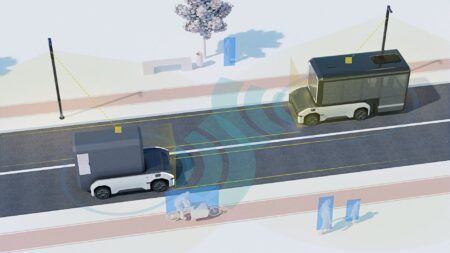Researchers at Sweden’s Chalmers University of Technology are finding inspiration from nature to help with the development of a driverless truck, which will take part in a competition organized as part of the EU’s Grand Cooperative Driving Challenge (GCDC) project for autonomous vehicles.
The first public demonstration of the team’s modified Volvo FH16 truck will take place on May 28 during the GCDC event, which will be on the A270 motorway between Helmond and Eindhoven in the Netherlands. The competition will see 10-15 universities compete against each other with autonomous vehicles. The team’s research has been conducted in the university’s new ‘Revere’ (Resource for Vehicle Research) lab, which is run by Chalmers and the ‘Safer’ vehicle and traffic safety center, in collaboration with AB Volvo and Volvo Cars, and with financial support from the Västra Götaland regional government.
Chalmers researcher Ola Benderius, the project’s team leader, explained that the traditional and dominant way of developing vehicles is to constantly base progress on earlier vehicle models and gradually add new functions, which might not work when developing the autonomous vehicles of the future. “Traditionally the aim has been to try to separate and differentiate all conceivable problems, and tackle them using dedicated functions, which means that the system must cover a large number of scenarios. You can cover a large number of cases, but sooner or later the unexpected occurs and that’s when an accident could happen,” Benderius observed.
His team of researchers have instead chosen to regard the self-driving vehicle as a completely new type of vehicle one that is more like an animal, a biological organism, than a technical system. Benderius explained, “Biological systems are the best autonomous systems we know of. A biological system absorbs information from its surroundings via its senses, and reacts directly and safely, like an antelope running with its herd, or a hawk swooping on its prey on the ground. Before humans walked the earth, nature already had a solution, so let’s learn from that. Our team is working toward achieving a transport revolution like when the horse was replaced by the motor car in the early 20th century.”
According to Benderius, “All the information that the truck compiles from sensors and cameras is converted into a format that resembles the way in which humans and animals interpret the world via their senses. This enables the truck to adapt to unexpected situations in its basic design. Instead of just one large program with dedicated functions for all conceivable situations, we are working on small and general behavioral blocks that aim to make the truck react to various stimuli, just like an animal does. The truck is programmed to constantly keep all stimuli within reasonable levels and will continuously learn to do this as efficiently as possible. This makes the framework extremely flexible and good at managing sudden and new dangers. We are trying to design a system that adapts to whatever happens, without pointing to specific situations. This is something that even the simplest animals can usually do better than existing vehicle solutions.”
The Chalmers software, OpenDLV (DriverLess Vehicle), is being developed as open source code and is freely available on the internet. Through this, the project group hopes that other researchers around the world can join the project by running and developing the software in their own vehicles. OpenDLV is intended to serve as an academic platform for researchers in many scientific disciplines, such as vehicle engineering, adaptive systems, computer science and engineering, perception, neurology and biology, where they can exchange knowledge about how autonomous vehicles should be made to enable a safe, large-scale introduction into society.




